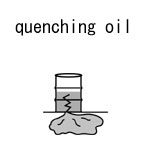| Case Name |
Outflow of quenching oil caused due to bumping from water contamination in a gas atmosphere furnace at a heat treatment factory |
| Pictograph |

|
| Date |
April 13, 1996 |
| Place |
Kawasaki, Kanagawa, Japan |
| Location |
Machine shop |
| Overview |
On April 13th, 1996. On starting operation of a gas atmosphere furnace at a heat treatment factory, quenching oil spouted from the end of the exhaust pipe. As the cooler of the quenching oil bath had been used for a long time, cooling water had leaked slightly. Leaked water entered into the quenching oil, and it was considered that water had been evaporated by the high temperature of parts. An inspection of the cooler had not been done for 13 years and a moisture analysis of quenching oil was done only once a year. A precursory signal was given two days before the accident. |
| Incident |
Quenching oil spouted out at a gas atmosphere furnace of a heat treatment factory. During carburizing work, quenching oil spouted from the end of exhaust piping which fed the unburned gas and a quenching oil mist to combustion equipment for unburned gas. |
| Processing |
Consumption and usage |
| Substance |
Quenching oil |
| Type of Accident |
Leakage |
| Sequence |
On April 11th, 1996. A small quantity of white smoke was found when the gas atmosphere furnace started automatically. A carburization inhibitor applied to products had discolored and peeled off.
08:00 on April 13th. Operation of the furnace started after inspection.
15:00. A sound was heard on operating the agitator in the quenching oil bath on manual.
17:00. Parts were charged into the quenching oil bath.
17:05. Quenching oil spouted from the end of the exhaust pipe, and the alarm was actuated. Operation was changed to manual and the interlock of the automatic conveyance machine was actuated. Then, oil that had spouted was collected.
17:13. The incident was reported to the fire department by telephone.
17:47. Recovery of oil and nitrogen substitution of carburization gas (mixed gas of methanol and LNG) were finished. The power supply of the heater was cut and work was completed.
The outflow was about 10 L.
On April 15th. The manufacturer of the quenching oil checked the oil for a water contamination. |
| Cause |
10 or more times greater than the standard value (0.1% or more) of moisture contaminated the quenching oil bath. Parts were thrown in under conditions in which this moisture was agitated and distributed. Therefore, water in the bath boiled rapidly, and it is considered that quenching oil spouted with steam.
There were no items of periodic inspection for the oil cooler, and inspection and cleaning had not been performed for about 13 years. Stress corrosion cracking had advanced inside, which was the water side of the cooler. A crack had probably penetrated two days before the accident, and cooling water is regarded to have contaminated the quenching oil.
The oil manufacturer only checked for contamination of the water by quenching oil once a year, and there was no daily check for water contamination, etc.
The material and the structure of the metal used for the condenser tube were normal. |
| Response |
The automatic conveyance machine was stopped. Leaked quenching oil was collected. Carburization gas was replaced by nitrogen. The heater was turned off. The incident was reported to the public fire department. |
| Countermeasures |
The water content of the quenching oil bath is checked with a chemical for detecting every day before work starts. A meeting is held once a week for all workers, with the aim of thorough education. |
| Knowledge Comment |
There had been no accidents since the plant started operation, but if neither daily check, which should be performed regularly, nor equipment check is performed, an accident is inevitable. |
| Background |
Service water is also a corrosion medium. Furthermore, corrosion can be accelerated by a change of temperature of water and quenching oil or quality of water. Without considering these factors the situation was left for 13 years, and stress corrosion cracking had started. Furthermore, although moisture measurement is one of the main points of quenching oil management, it was done only once a year. Moreover, measurement was left to the quenching oil manufacturer. This is considered to be a sign of a lack of operation management and facility management, as no accidents had occurred for a long time. It had been forgotten that quenching oil is also combustible and may be deteriorated. It is judged that maintenance was deficient. |
| Incidental Discussion |
There are many accidents due to quenching oil. Since quenching oil is not nominated as a dangerous material, is the quenching oil thought as non-combustible liquid? |
| Reason for Adding to DB |
Example of leakage of quenching oil caused due to water contamination |
| Scenario |
| Primary Scenario
|
Poor Value Perception, Poor Safety Awareness, Inadequate Risk Recognition, Organizational Problems, Poor Management, Slackness of Management, Misjudgment, Narrow Outlook, Influences of Water was Out of Thought 'Lack of Imagination', Usage, Maintenance/Repair, No Inspection among 13 Years, Failure, Abrasion, Corrosion, Secondary Damage, External Damage, Leakage
|
|
| Sources |
Kawasaki City Fire fighting station, Prevention division, Peace section. The T Co., Ltd. machine shop. Incident of quenching oil spill at a gas atmosphere furnace (heat treatment factory). Material of the Kawasaki City complex safety countermeasure committee
|
| Physical Damage |
About 10 L of quenching oil flowed out. |
| Financial Cost |
¥ 2,000 (Material of the Kawasaki City Complex safety countermeasures committee) |
| Field |
Chemicals and Plants
|
| Author |
ITAGAKI, Haruhiko (Japan National Institute of Occupational Safety and Health)
TAMURA, Masamitsu (Center for Risk Management and Safety Sciences, Yokohama National University)
|